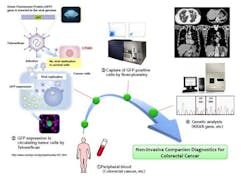Noninvasive method can capture circulating tumor cells from blood samples for genetic testing
Medical researchers at Okayama University in Japan are seeking partners to commercialize their clinically proven, noninvasive, fluorescence virus-guided capture system of human colorectal circulating tumor cells (CTCs) from blood samples for genetic testing. Their work holds strong promise for personalized targeted cancer therapy.
Related: Molecule locates and penetrates prostate cancer cells to enable imaging, therapy
The research, which is led by Professor Toshiyoshi Fujiwara of the Okayama University Graduate School of Medicine, Dentistry, and Pharmaceutical Sciences, involves targeting the high telomerase activity of malignant tumor cells with green fluorescent protein (GFP)-expressing, telomerase-specific replication adenovirus (OBP-401, dubbed TelomeScan and manufactured by Tokyo-based Oncolys BioPharma) to be able to capture extremely low quantities of live CTCs from millions of background blood leukocytes.
Fujiwara and colleagues have previously reported on clinical tests on OBP-401-based GFP labeling to detect live CTCs in gasterointestinal and ovarian cancers.
With this latest work, Fujiwara and his team show that their OBP-401 based CTC capture system enables the monitoring of genetic mutations in both epithelial and mesenchymal types of CTCs, thereby opening up the possibility of a new noninvasive companion diagnostic method for genetic testing and personalized medicine.
"This 'liquid biopsy' via a simple blood test could be carried out in real time and enables optimized and timely decisions for therapeutic intervention," state the researchers.
Combining the OBP-401-based CTC capture system and genetic testing enabled the detection of KRAS and BRAF gene mutations in blood samples taken from patients with colorectal cancer. Notably, these mutations were determined to be identical to the ones seen in the primary tumors of the patients.
Full details of the work appear in the journal Gut; for more information, please visit http://dx.doi.org/10.1136/gutjnl-2014-306957.
-----
Don't miss Strategies in Biophotonics, a conference and exhibition dedicated to development and commercialization of bio-optics and biophotonics technologies!
Follow us on Twitter, 'like' us on Facebook, and join our group on LinkedIn
Subscribe now to BioOptics World magazine; it's free!
